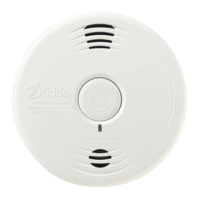3. Locations to Avoid
• Do not install within 0.9 m (3’) of the following: The door to a
kitchen, or a bathroom that contains a tub or shower, forced air
supply ducts used for heating or cooling, ceiling or whole house
ventilating fans, or other high air-flow areas.
• Do not place the alarm where drapes or other objects will block
the sensor. Smoke must be able to reach the sensor to accurately
detect conditions.
• Do not install in peaks of vaulted ceilings. In this area install as
shown in images 2B and 2C.
• Install at least 30.5 cm (12”) away from fluorescent lights as
electronic noise may cause nuisance alarms.
• Keep out of insect infested areas. Avoid excessively dusty, dirty or
greasy areas. Dust particles may cause nuisance alarms or failure
to alarm.
• Extreme temperatures may affect the sensitivity of the alarm.
Do not install in areas where the temperature is colder than
4.4°C (40°F) or hotter than 37.8°C (100°F), such as garages and
unfinished attics.
• Do not install in areas where the relative humidity (RH) is greater
than 95%, non-condensing. Very humid areas, with moisture or
steam, can cause nuisance alarms.
• Normal cooking may cause nuisance alarms. If a kitchen alarm
is desired, it should have an alarm silence feature or be a
photoelectric type.
• Do not place in the garage. Particles of combustion are present
when you start your automobile.
• Smoke alarms are not to be used with detector guards unless the
combination (alarm and guard) has been evaluated and found
suitable for that purpose.
• Do not install within 6ft of heating or cooking appliances

